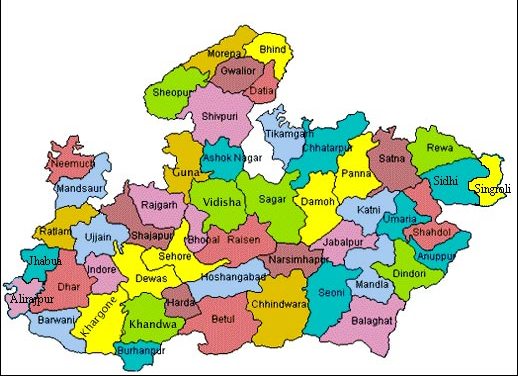Madhya Pradesh – State’s information – UPSC 24/05/2019 – Posted in: STATE SERIES – Tags: Madhya Pradesh
MADHYA PRADESH
It is a part of peninsular plateau of India lying in north central part, whose boundary can be classified in the north by the plains of Ganga-Yamuna, in the west by the Aravali, east by the Chhattisgarh plain and in the south by the Tapti valley and the plateau of Maharashtra.
Madhya Pradesh meaning “Central Province” is a state in central India. Nicknamed the “Heart of India” due to its geographical location, Madhya Pradesh is the second largest Indian state by area.
The state straddles the Narmada River, which runs east and west between the Vindhya and Satpura ranges; these ranges and the Narmada are the traditional boundary between the north and south of India.
Madhya Pradesh is also known as the ‘Tiger State’ and has 6 wild life Sanctuaries and Reserves.
| Capital | Bhopal |
| Date of Formation |
|
| Number of Districts | 51 |
| State Boundaries | Rajasthan, Uttar Pradesh, Chhattisgarh, Maharashtra, Gujarat. |
| Historical sites | Bhimbetka, Adamgarh, Pachmarhi, Raisen, Jaora. |
| Important Dynasties | Ashoka, Kushan, Satvahanas |
| State Bird | Paradise Flycatcher |
| State Animal | Swamp Deer (Barasingha) |
| State Tree | Banyan Tree |
| State Flower | Madonna Lilly |
| State Fish | Mahasheer |
| Rivers | Narmada, Tapi, Betwa, Son, Chambal, Shipra, Ken, Pench, Wanganga, Wardha |
| Waterfalls | Dhuandhar Jabalpur, Bee fall, Patalpani, Chachi waterfall |
| National Parks |
|
| Language Spoken |
|
| Regional dialects |
|
| Fairs | Simhastha, Aalami tableegi ijtima, Fair of ramlila, Fair of hira bhumia, Fair of pir budhan, Fair of nagaji, Fair of tetaji, Fair of jageshwari devi, Amarkantak shivratri fair, Fair of mahamrityunjay, Fair of chandi devi, Urs of baba shahabuddin aulia, Fair of kaluji maharaj, Fair of singaji, Dhamoni urs, Fair of barman, Fair of math ghoghara |
| Festivals | Khajuraho dance festival, Gana-Gour, Ganga, Dashami, Hareli, Simhastha, Tensen music festival, Chethiyagiri vihara festival, Lokrang festival, Lokranjan festival |
| Music | Relo songs |
| Dance | Gaur dance, Muria dance, Karma, Bhagoria, Baredi, Ahirai, Naurata, Badhai, Matki |
| Art & Crafts | Wall paintings/ Bhitti chitras, Chippa bagh/ hand-block printers, Battubai dolls |
| Minerals | Diamond, Manganese, Sandstone, Limestone, Copper |
| World Heritage sites | Sanchi stupa, Rock shelter of Bhimbetka, Groups of temples-Khajuraho |
| Tribes | Bharia, Panika, Agariya, Baiga, Bhil, Gond, Halba, Korku, Mariya, Sahariya |
| Wildlife Sanctuaries |
|
| Institutions |
|
| Soils | Black, Red, Alluvial, Laterite, Mixed soil |
| Agro-Climatic Zone |
|
| Ramsar Sites | Bhoj wetland |
| Forest Trees | Teak, Sal, Bamboo and Tendu |
| Crops | Wheat, Soybean, Jowar, Paddy, Pulses, Cereals, Groundnut |
| Cash Crops | Cotton, Sugarcane, Oil Seeds |
| Legends | Tansen, Raja Chhatrasal, Rani Ahilya Bai, Rani Durgawati, Rani Lakshmi Bai, Chandra Shekhar Azad, Tantiya, Vijaya Raje Scindia, Ustad Allauddin Khan, Krishan Rao Pandit, Ustad Ammir Khan |
| Potential Cluster |
|
Facts:
- Pench and Kanha forests in the Satpura ranges, and Bandhavgarh in the Vindhyas, are all tiger reserves.
- One half of Bhawani Mandi station on the Mumbai- Delhi railway line lies in Madhya Pradesh and the other half lies in Rajasthan.
- The narrow and long Narmada-Son valley runs almost through the entire state from east to west making the area fit for agricultural activities.
- The highest point in Madhya Pradesh is Dhupgarh, with an elevation of 1,350 m.
- The River Narmada flows through a gorge of marble rocks in Bhedaghat, Jabalpur
- Chanderi and Maheshwari is famous for traditional handicrafts and handloom clothes
- Nepanagar has news print factory
- Bina – Refinery.
- Hosangabad – Security Paper mill.
- Dewas is famous for Bank Note Press.
- Big reserves of Manganese are found in Balaghat and Chhindwara districts.
- The state also produces about 45% of Bauxite in India with Jabalpur, Mandla, Shahdol, Satna and Rewa being the important Bauxite producing centers.
- Iron ore deposits are found in Balaghat, Jabalpur and Mandla districts.
- The State of Madhya Pradesh also has rich reserves of coal in the northeastern and Satpura regions.
- The state has the distinction of being the only diamonds producing state in India, with production in Panna and Chhatishgarh districts.
- Mandsaur is the largest opium producing district in the country.
- 31 % of the lands under forest cover with a largely unexploited species of rare, Valuable medicinal-herbal plants.
- Largest producer of soyabean, pulses, gram, and garlic.
- Third largest producer of cement in India.
- Over 144 BCM of coal bed methane reserves available.
- Asia’s thickest coal seam located in the district of Sidhi.
- Madhya Pradesh has the only working diamond mine in India.
- Manganese and dolomite, key ingredient to iron and steel, found here.
- Exotic varieties of dimensional stones i.e. marble, granite and flagstone available.
- Largest producer of oilseeds and pulses in the country.
- 25.3% of pulses and 36% Grams of total production of the country grown here.
- Commercially favoured varieties of wheat and potato grown.
- Largest producer of garlic and coriander.
You can follow us on LinkedIn and for more updates related to UPSC IAS Preparation, Like our Facebook Page and subscribe our Diligent IAS Youtube Channel
Also read more about other Indian States

